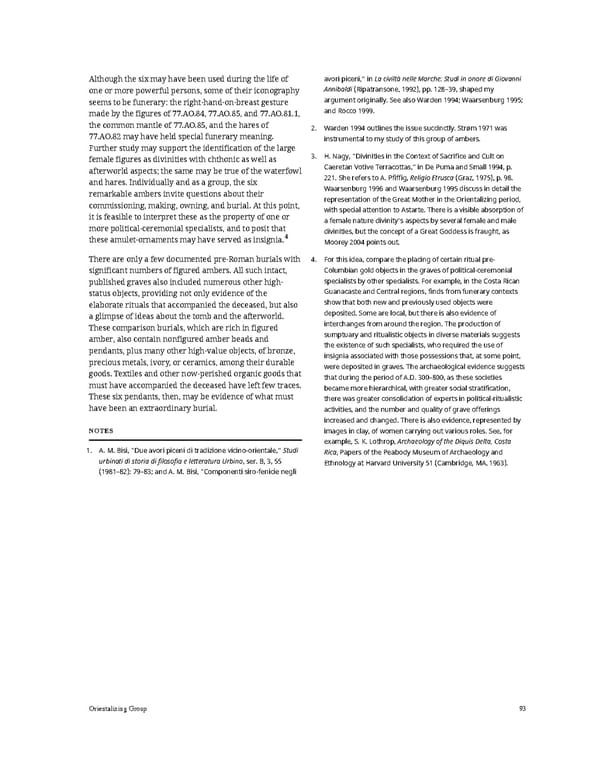Although the six may have been used during the life of avori piceni,” in La civiltà nelle Marche: Studi in onore di Giovanni one or more powerful persons, some of their iconography Annibaldi (Ripatransone, 1992), pp. 128–39, shaped my seems to be funerary: the right-hand-on-breast gesture argument originally. See also Warden 1994; Waarsenburg 1995; made by the figures of 77.AO.84, 77.AO.85, and 77.AO.81.1, andRocco 1999. the common mantle of77.AO.85, and the hares of 2. Warden 1994outlines the issue succinctly. Strøm 1971 was 77.AO.82may have held special funerary meaning. instrumental to my study of this group of ambers. Further study may support the identification of the large female figures as divinities with chthonic as well as 3. H. Nagy, “Divinities in the Context of Sacrifice and Cult on afterworld aspects; the same may be true of the waterfowl Caeretan Votive Terracottas,” in De Puma and Small 1994, p. and hares. Individually and as a group, the six 221. She refers to A. Pfiffig, Religio Etrusca (Graz, 1975), p. 98. remarkable ambers invite questions about their Waarsenburg 1996andWaarsenburg 1995discuss in detail the commissioning, making, owning, and burial. At this point, representation of the Great Mother in the Orientalizing period, it is feasible to interpret these as the property of one or with special attention to Astarte. There is a visible absorption of more political-ceremonial specialists, and to posit that a female nature divinity’s aspects by several female and male 4 divinities, but the concept of a Great Goddess is fraught, as these amulet-ornaments may have served as insignia. Moorey 2004points out. There are only a few documented pre-Roman burials with 4. For this idea, compare the placing of certain ritual pre- significant numbers of figured ambers. All such intact, Columbian gold objects in the graves of political-ceremonial published graves also included numerous other high- specialists by other specialists. For example, in the Costa Rican status objects, providing not only evidence of the Guanacaste and Central regions, finds from funerary contexts elaborate rituals that accompanied the deceased, but also show that both new and previously used objects were a glimpse of ideas about the tomb and the afterworld. deposited. Some are local, but there is also evidence of These comparison burials, which are rich in figured interchanges from around the region. The production of amber, also contain nonfigured amber beads and sumptuary and ritualistic objects in diverse materials suggests pendants, plus many other high-value objects, of bronze, the existence of such specialists, who required the use of precious metals, ivory, or ceramics, among their durable insignia associated with those possessions that, at some point, goods. Textiles and other now-perished organic goods that were deposited in graves. The archaeological evidence suggests must have accompanied the deceased have left few traces. that during the period of A.D. 300–800, as these societies became more hierarchical, with greater social stratification, These six pendants, then, may be evidence of what must there was greater consolidation of experts in political-ritualistic have been an extraordinary burial. activities, and the number and quality of grave offerings increased and changed. There is also evidence, represented by NOTES images in clay, of women carrying out various roles. See, for example, S. K. Lothrop, Archaeology of the Diquis Delta, Costa 1. A. M. Bisi, “Due avori piceni di tradizione vicino-orientale,” Studi Rica, Papers of the Peabody Museum of Archaeology and urbinati di storia di filosofia e letteratura Urbino, ser. B, 3, 55 Ethnology at Harvard University 51 (Cambridge, MA, 1963). (1981–82): 79–83; and A. M. Bisi, “Componenti siro-fenicie negli Orientalizing Group 93
 Ancient Carved Ambers in the J. Paul Getty Museum Page 102 Page 104
Ancient Carved Ambers in the J. Paul Getty Museum Page 102 Page 104